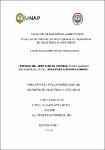Estudio del arte para el control físico químico microbiológico del agua para consumo humano
Abstract
El agua es uno de los recursos naturales fundamentales y es uno de los cuatro recursos básicos. Posee propiedades únicas, es una molécula sencilla formada por tres pequeños átomos. El agua no debe presentar ningún tipo de riesgo que pueda causar daño, irritación química, intoxicación o infección microbiológica.
Debido a estas condiciones, en el caso de los microorganismos no existe un límite tolerable; por lo que el agua destinada al consumo humano no debe contener ningún agente patógeno. El peligro más común con relación al agua de consumo humano es la contaminación, directa o indirectamente debido a la acción de las aguas estas pueden ser, según su procedencia debido a factores fisicoquímicos y ambientales.
En este trabajo se describirá: la composición de las aguas, la calidad del agua para diferentes usos y las características físicas, químicas y microbiológicas usados como indicadores de calidad. Así mismo se resaltará la importancia de la representatividad del muestreo y la calidad de las mediciones químicas. Water is one of the fundamental natural resources and it is one of the four basic resources. It has unique properties; it is a simple molecule made up of three small atoms. The water must not present any type of risk that could cause damage, chemical irritation, intoxication or microbiological infection. Due to these conditions, in the case of microorganisms there is no tolerable limit; therefore, water intended for human consumption must not contain any pathogenic agents. The most common danger in relation to water for human consumption is contamination, directly or indirectly due to the action of the waters, these can be, depending on their origin, due to physicochemical and environmental factors. This work will describe: the composition of the water, the quality of the water for different uses and the physical, chemical and microbiological characteristics used as quality indicators. Likewise, the importance of the representativeness of the sampling and the quality of the chemical measurements will be highlighted. Water is one of the fundamental natural resources and it is one of the four basic resources. It has unique properties; it is a simple molecule made up of three small atoms. The water must not present any type of risk that could cause damage, chemical irritation, intoxication or microbiological infection. Due to these conditions, in the case of microorganisms there is no tolerable limit; therefore, water intended for human consumption must not contain any pathogenic agents. The most common danger in relation to water for human consumption is contamination, directly or indirectly due to the action of the waters, these can be, depending on their origin, due to physicochemical and environmental factors. This work will describe: the composition of the water, the quality of the water for different uses and the physical, chemical and microbiological characteristics used as quality indicators. Likewise, the importance of the representativeness of the sampling and the quality of the chemical measurements will be highlighted.


